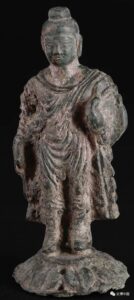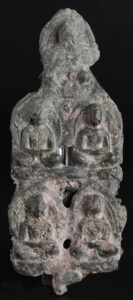 Two statues that are the earliest known freestanding Buddha statues ever found in China have been discovered in an 2nd century tomb in the Chengren Village neighborhood of Xianyang City. Before this find, archaeologists believed that Buddhist statues appeared in China in the Sixteen Kingdoms period (304-439 A.D.).
Two statues that are the earliest known freestanding Buddha statues ever found in China have been discovered in an 2nd century tomb in the Chengren Village neighborhood of Xianyang City. Before this find, archaeologists believed that Buddhist statues appeared in China in the Sixteen Kingdoms period (304-439 A.D.).
A team from the Shaanxi Provincial Institute of Archaeology made the finds in May during an excavation of a family cemetery from the late Eastern Han Dynasty (25-220 A.D.). There were six tombs in the ground. The two bronze Buddha statues were unearthed in the northwest corner of tomb M3015.
One statue is a Buddha standing on a lotus flower. It is 10.5 cm (4.1 inches) high and 4.7 cm (1.85 inches) wide at the base. Gautama Buddha is depicted with his hair in a small, flat bun on top of his head and wearing a robe draped from the left shoulder to the right. His left arm is bent at the elbow, hand holding the corner of the cassock. His right hand is raised, but damaged.
 The second statue is a depiction of the Five Tathāgatas, five Buddhas embodying different aspects of the enlightenment principle. It is 15.8 cm (6.2 inches) high and 6.4 cm (2.5 inches) wide. The Buddhas are seated on lotuses and also wear robes and hair buns.
The second statue is a depiction of the Five Tathāgatas, five Buddhas embodying different aspects of the enlightenment principle. It is 15.8 cm (6.2 inches) high and 6.4 cm (2.5 inches) wide. The Buddhas are seated on lotuses and also wear robes and hair buns.
The buns, faces and clothing of both works are typical of statues made in Gandhara (today part of Pakistan and Afghanistan), but technical analysis of the copper alloy used in their manufacture revealed that they were locally produced. That means that Buddhist art and iconography, transmitted from India over the Silk Road, were already well-established in China by the 2nd century.
Tradition has it that Buddhism was introduced to China in the reign of Emperor Ming of Eastern Han (r. 57-75 A.D.). Buddhist imagery appeared on objects in southwest and southeast China at this time, but only as decorative motifs on objects and buildings.
“The owner of the graveyard was possibly a county official or landlord, who had certain family influence and economic might,” [Shaanxi Academy of Archaeology researcher] Li said.
“The findings of the Buddha statues are of great significance to the study of the introduction of Buddhist culture to China and its localization in the country,” Li added.